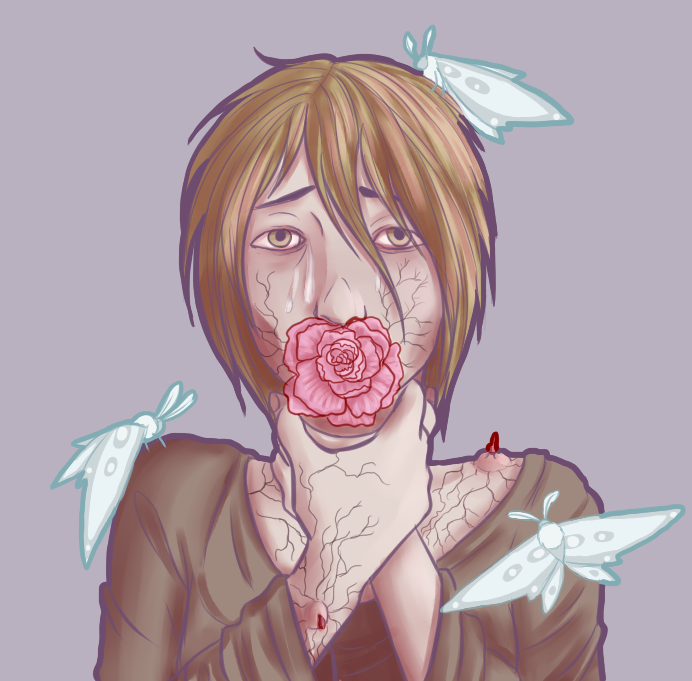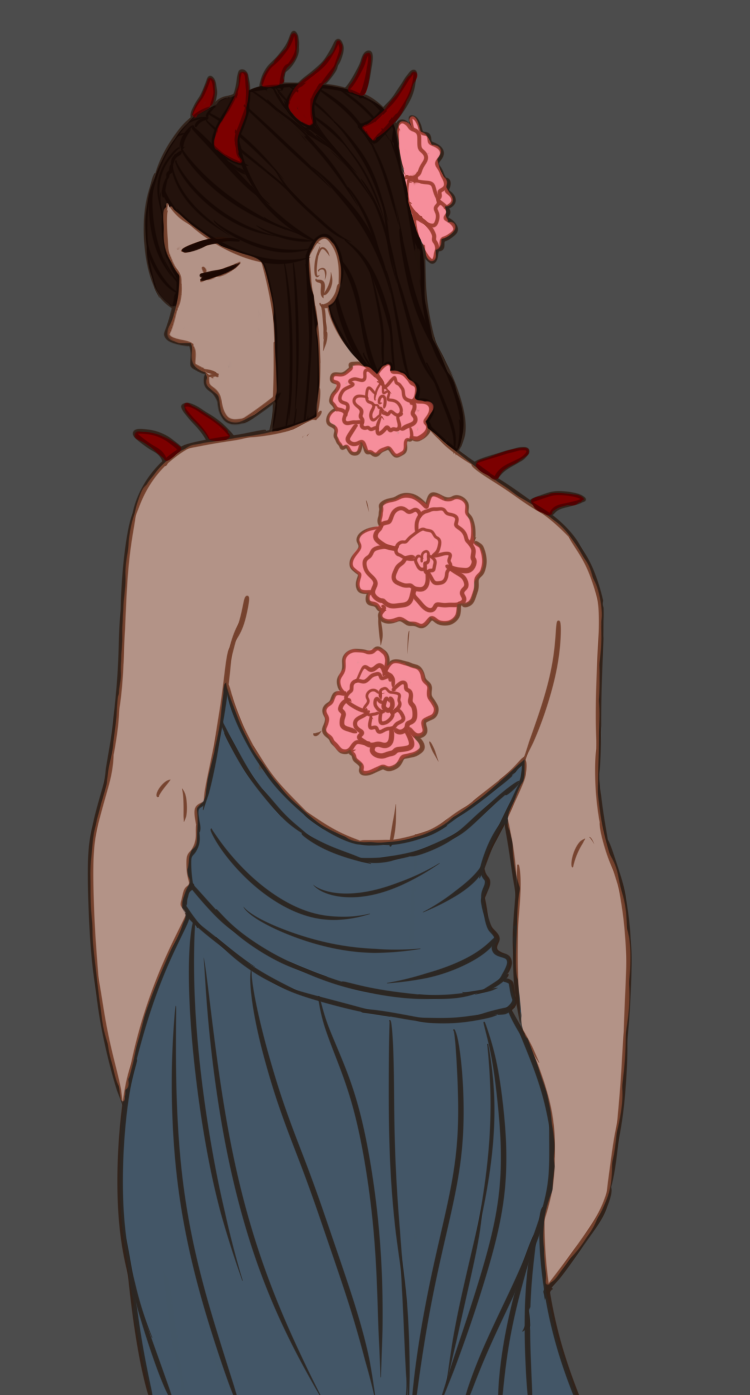Bloodbloom
The Blooming Disease
Content Warning: This article contains drawings of and some descriptions of illness and body horror.
10th Rise of Entier -- Year 348AA
Regarding -- Assessment of a Bloodbloom outbreak.
Length -- Estimated 2 weeks
Precautions -- Sealed suit, vaccinated, emergency booster shots and treatments packed, gas mask with fine filter
Thousands of pearl moths reflected rainbows in the daylight and settled wherever they could find. Those still up and moving about the village were suffering from wheezing and coughing, others itching at the delicate dark roots that branched just under their skin. It seemed they had given up trying to protect themselves from infection; in fact it seemed there was no one there that wasn't infected. There were a few homes that had been marked for as deceased. Inside I found corpses with short, blood red stalks rising from split skin and a large, pale pink flower blooming from their chests. They had been placing the dead from other, still inhabited homes into these few houses, and there were more dead than I had originally guessed from only the flower marks on the doors.
There hasn't been a recorded Bloodbloom outbreak for over 50 years. A few cases here and there, but nothing lethal. This all could have been avoided had misinformation and fear-mongering not taken such a hold on the populace. People were refusing medication because of the temporary side effects, which is like refusing life-saving surgery because it'll ache for a while. The end result is you take the medication, or you have a flower bursting out of your chest. Absolute idiots, the lot of them. The next time I hear "Bloodbloom treatment actually makes Bloodbloom worse" I am going to break their nose.
Transmission & Vectors
Bloodbloom is spread through the seeds that is released by open tongueflowers and in the liquid inside of tongueflower stalks. Any piece of tongueflower that is ingested can also cause it to spread due to the immense amounts of pollen that coats the flower usually. Tongueflowers are a parasite that thrive within the warm bodies of mammals. Once roots begin to show, a person is infected completely with Bloodbloom and their blood, bodily fluids, breath and even touch can be infectious due to the nature of the seeds, which are very small and very sticky. After the first bud emerges from under one's tongue and blooms out from their mouth, the tongueflower will begin to produce the dust-like seeds to further the spread, making the victim even more infectious than before. The seeds, though extremely tiny, are quite hardy, especially in warmer climates. Large moths known as pearl moths are attracted to tongueflowers, which are not poisonous to them, and often feed on the seeds and spread it further.
Causes
Bloodbloom is caused by direct contact with tongueflower. The stalks are deep red at the base and slowly fades to a pale pink as it rises. More tongueflowers will often grow from a single stalk, which can grow up to 8 ft (2.4 m) tall. The large, ruffled flowers are a rich pink color, which led to the name. Its petals taste incredibly sweet and melt like sugar on the tongue. The tongueflower is covered with a light dusting of near-white microseeds which, when ingested by most mammals, will make its way to the stomach and will be activated by the acidity and heat. At this point, the seeds will attach to the stomach lining and slowly sink into it. Once this occurs, the victim is considered infected.
Tongueflowers are parasites that use the body of mammals instead of soil. The flowers root into people's veins, using their blood for nutrients. The plants prefer warmer climates, and winters tend to have much less risk of infection, as tongueflowers don't bloom in cold weather. Snow will kill even the buds and roots, which eventually causes the stalks to wither away.
Symptoms
Early Stage Symptoms
~ Itchy, prickling skin~ Abdominal pain
~ Upset stomach
~ Dizziness, fatigue
~ Shortness of breath
~ Cloudy, pale bodily fluids
~ Increased appetite
~ Muscle weakness
~ Low blood pressure
Middle Stage Symptoms
~ Extremely itchy skin~ Swelling lumps along large veins
~ Coughing, wheezing, shortness of breath
~ Roots faintly visible under skin
~ Lump in the mouth, under the tongue
~ Ashy complexion
~ Pearl moths attracted to infected
~ Coughing up dust-like seeds
~ Vomiting
Treatment
Treatment is a medication called kabbesine, which is made from a mixture of chemicals that include a chemical inside the stomach acid of a kabbe, a large reptilian herbivore that eats tongueflower regularly. They have proven to be entirely immune to the effects of the tongueflower, as their stomach acid is lethal to the plant and doesn't allow its seeds to attach to the stomach lining. This is the chemical used to kill all traces of tongueflower, which withers and dissolves and can then be broken down by the body. When done correctly, treatment will cause tongueflowers to begin blooming through the skin in place of the stalks, and will bloom quickly in order to spread as many seeds as they can before the entire system is killed by the kabbesine. Roots will become much closer to the skin, giving the appearance of more extensive and even larger roots.
Though the medication isn't expensive or difficult to make, large outbreaks of Bloodbloom can be dangerous due to the difficulty of transporting the medication quickly to where it's needed. The creators of the medication are the Blooms; plant-based Suplum infected with chronic Bloodbloom, and have a symbiotic relationship with tongueflowers, though this makes them very infectious to be around. Blooms are unable to leave their colonies due to their infectious nature, as well as others attacking them for the same reason, and not many merchants visit the Bloom colonies. All of this makes it very difficult to get medication to clinics where they can be administered, especially when there is a sudden outbreak.
Prognosis
Stage One: Infection
When the dust-like seeds are ingested, they embed in the stomach lining and use the absorbed nutrients as food to begin growing. Symptoms usually slight abdominal pain, steadily growing appetite, and upset stomach. This stage lasts up to 7 days and can take up to the last two before symptoms begin to manifest.Stage Two: Rooting
Stage two begins when the seeds begin to produce roots that will burrow through the stomach lining to find veins. These roots are dark, and absorb nutrients through the blood. As the roots begin to spread, hosts may experience symptoms such as moderate abdominal pain, dizziness, low blood pressure, some muscle weakness, fatigue, upset stomach, and itching sensations under the skin. The seeds are large enough at this point to split open and begin releasing more seeds to saturate the host in case they are eaten by another animal, so that the new animal becomes infected. Because of the amount of seeds, tears and saliva becomes cloudy. During this stage, pearl moths may seem more attracted to a host than is usual; they will settle on the host or nearby the host. This stage lasts up to 10 days, with symptoms steadily worsening.Stage Three: Budding
Stage three begins when the roots become clearly visible on the skin. The host suffers from an uncontrollable itching and burning sensation under the skin where the roots are. Small lumps begin forming about two feet apart on the body. A large lump begins to form underneath the tongue, on the frenulum. Saliva functions begin to drop quickly. Coughing and wheezing are abundant, as is labored breathing; coughing often is accompanied by cloudy breath from the seeds escaping. Appetite begins to drop drastically as abdominal pain spreads towards the chest. The host's skin will often become ashy and pale. Later on in this stage, the skin over the lumps begins to split as small red buds grow out. Pearl moths land often on the host now, returning even when brushed away. They will be attracted to areas the host frequents. This stage lasts up to 6 days. Deaths that occur during this phase are usually due to the hosts being in poor health before infection, or those that are very young or very old.Stage Four: Blooming
Stage four begins when the bud under the host's mouth blooms, pushing the tongue to the back of the mouth and making ingestion and breathing even more difficult. The red buds on the skin reach about 2 inches in diameter before they begin blooming into tongueflowers. At this stage, hosts do not move much, and are usually bed-bound with extreme muscle weakness, dizziness, low blood pressure, fainting, and extreme fatigue. Pearl moths often swarm hosts at this stage, though the hosts are too weak to brush them away. Near the end of this stage, the roots dig into the chest and into the arteries of the heart, at which point the host is considered lost. Less than a day later another bloom pushes through the chest over the heart, and blooms within 24 hours, at which point the host dies from heart failure. The entire stage can last up to 4 days. The majority of deaths occur during this stage, when at the beginning even healthy people can succumb to suffocation, blood loss, or artery blockages.Stage Five: Integration
Once the host has died, the roots will break from the skin and begin to quickly burrow into the ground. The center of the tongueflowers will sprout a deep red stalk, which will start growing quickly as the petals begin to die. The roots will often overtake the body completely within a week; decomposition is often rapid, but draws in scavengers and other meat-eaters which will spread the tongueflower seeds.Exceptions
An exception occurs when Suplum with a plant-based Gift usually describe it as a pleasant feeling; they feel energized and show above average strength, as well as heightened resilience against sicknesses. Blooms quickly grow used to pearl moths, as they will land on the exposed flowers along the Bloom's back. Bloom have milky white tears and saliva, and their blood tends to be a pale pink instead of deep red. The tongueflowers still release seeds and make the Blooms incredibly infectious, and they are often attacked or even killed due to this.Sequela
When healing, patients can expect vomiting and coughing episodes for up to a week. People who have suffered from bloodbloom are more likely to develop digestive issues and lung issues such as asthma. Those who have had Bloodbloom once and survived have such a heightened resistance to it that it is extremely rare for a previously infected person to contract it again. Suplum who have become Blooms (those exceptions that can live symbiotically with tongueflowers) are often immune to most other illnesses, and those they are not immune to they have a heightened resilience against. They find themselves with greater strength, stamina, and speed.
Hosts & Carriers
Pearl moths are often carriers of tongueflower pollen. They are not affected by it at all, and can carry it for quite a long time. Some Suplum can also carry the disease without dying, though these cases are rare and they are highly infectious. Many birds can carry tongueflower pollen without any symptoms.
Prevention
Because of bloodbloom's extremely infectious nature, the best way to prevent it is to wear a sealed suit and a gas mask. Eating kabbe meat can be helpful in preventing infection. There is medication similar to the cure for bloodbloom that strengthens one's stomach so seeds cannot burrow, and will pass harmlessly through the system. Making sure that animals hunted for food are not infected is also an important part of prevention. Cold will also prevent tongueflower seeds from activating, which is why many people will freeze or chill their food and water before eating it.
Epidemiology
Bloodbloom is often spread by animals that eat a tongueflower due to its sweet smell and taste, which then is passed on to humans when they eat the animal or care for it. Hotter conditions are better for tongueflowers and they produce more pollen. People living in close quarters are often at more risk for spreading infection. Those who do not seek medical treatment sooner rather than later become more and more infectious as time passes. Large groups of the population refusing vaccinations can also lead to vicious Bloodbloom outbreaks.
History
The first possible instance of bloodbloom is from long before the Borders rose around Kollark. An oral legend that is localized around the area that is now northern Lucem states that the ancient Aidia fell in love with a mortal who grew tongueflowers for their sweet taste. They pined after her but dare not move close lest they pull her happiness from her, like they did all other mortals. One day, thieves attacked the woman for her goods, killed her, and burned her fields. In a fit of vengeance, Aidia was rumored to stuff the flowers down their throats until they were stuffed and coughing up blood, and she cursed them to live with the flowers within them until the end of their lives.
The first recorded instance was also from before the Borders rose, and a small outbreak occurred in a village in present-day Rosenkantz. It was considered an anomaly until an epidemic rippled across the continent, killing nearly half the population off before kabbe were discovered eating tongueflowers. Kabbe were mass bred and let loose to eat the flowers, ruining a large part of the ecosystem but also decimating the tongueflower population.
The most famous case of bloodbloom was the infection of Prince Rower Daumier of Lucem in the year 83 AB. He was a Suplum with an affinity for trees. An outbreak began at the castle, and Prince Rower's moved like wildfire through him. He was soon overtaken, and many thought him dead, but instead he became the first Bloom. He was studied by many afterwards, until the fear of his infectiousness became too much for the people of Lucem and they demanded his exile or execution. His parents sent him away and he was supposedly never seen again, though rumors of people sighting him have persisted long after his possible lifetime. The love his people once had for Prince Rower and the terror of the creation of the first Bloom spread across the Borders, to the point where nearly everyone knows of the case and of him. Research has been done into where he ended up, and the most accepted theory is that he was sent to an island off of Lucem's northest coast and lived out the rest of his days there comfortably.
Cultural Reception
The gruesome nature of bloodbloom makes it very feared among the population of Lucem.
Pearl moths are feared and despised because of their association with the tongueflowers and their presence during a bloodbloom infection. A pearl moth is considered a sign of disease, death, and uncleanliness. Kabbe, due to their curative properties, are often kept on farms and treated well. They are sometimes kept as pets, as a superstition that they warded off bloodbloom just by being nearby is still deeply ingrained in the culture. Suplum known as Blooms who experience the very rare non-lethal version of bloodbloom are extremely feared and hated. Often they are killed so that they will not infect anyone else, while others manage to escape this fate. There are usually small settlements of Blooms that have found each other and live together in order to protect themselves and others from being infected. These outposts are known to be raided and burned during or after large bloodbloom breakouts in a sort of witch hunt.








Fantastic! I love the illustrations, they really add to the article! :D
Thank you!! I only wish I'd had time to draw the Blooms before the deadline. I'll add get to it eventually!